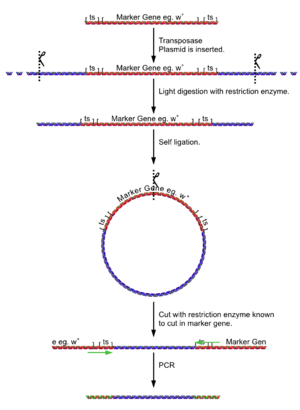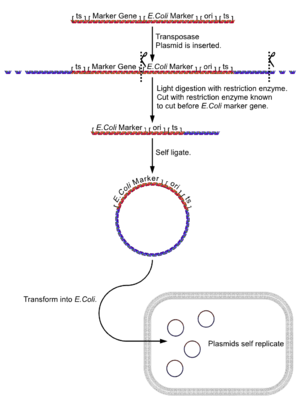Transposons as a genetic tool
Transposons are semi-parasitic DNA sequences which can replicate and spread through the host's genome. They can be harnessed as a genetic tool for analysis of gene and protein function. The use of transposons is well developed in Drosophila, in which P elements are most commonly used, in Thale cress (Arabidopsis thaliana) and in bacteria such as Escherichia coli [1] [2].
P Elements as a Tool (Drosophila)
Naturally-occurring P elements contain:
- Coding sequence for the enzyme transposase
- Recognition sequences for transposase action
Transposase is an enzyme that regulates and catalyzes the excision of a P element from the host DNA, cutting at two recognition sites, and then reinserts randomly. It is the random insertion that may interfere with existing genes, or carry an additional gene, that can be used for genetic research.
To use this as a useful and controllable genetic tool the two parts of the P element must be separated to prevent uncontrolled transposition. The normal genetic tools are therefore:
- DNA coding for transposase (or occasisonally simply transposase) with no transposase recognition sequences so it cannot insert.
- A "P Plasmid"
P Plasmids always contain:
- A Drosophila reporter gene, often a red-eye marker (the product of the white gene).
- Transposase recognition sequences.
And may contain:
- A gene of interest
- An E. coli reporter gene, often some kind of antibiotic resistance.
- Origin of replication and other associated plasmid 'housekeeping' sequences.
Methods of Usage (Drosophila)
(Forward genetics methods) There are two main ways to utilise these tools:
Fly Transformation
(hoping for insertion in non coding regions)
- Microinject the posterior end of an early-stage (pre-cellularization) embryo with coding for transposase and a plasmid with the reporter gene, gene of interest and transposase recognition sequences.
- Random transposition occurs, inserting the gene of interest and reporter gene.
- Grow flies and cross to remove genetic variation between the cells of the organism. (Only some of the cells of the organism will have been transformed. By breeding only the genotype of the gametes is passed on, removing this variation).
- Look for flies expressing the reporter gene. These carry the inserted gene of interest, so can be investigated to determine the phenotype due to the gene of interest.
It is important to note that the inserted gene may have damaged the function of one of the host's genes. Several lines of flies are required so comparison can take place and ensure that no additional genes have been knocked out.
Insertional Mutagenesis
(hoping for insertion in coding region)
- Microinject the embryo with coding for transposase and a plasmid with the reporter gene and transposase recognition sequences (and often the E. coli reporter gene and origin of replication, etc.).
- Random transposition occurs, inserting the reporter gene randomly. The insertion tends to occur near actively transcribed genes, as this is where the chromatin structure is loosest, so the DNA most accessible.
- Grow flies and cross to remove genetic variation between the cells of the organism (see above).
- Look for flies expressing the reporter gene. These have experienced a successful transposition, so can be investigated to determine the phenotype due to mutation of existing genes.
Possible mutations:
- Insertion in a translated region => hybrid protein/truncated protein. Usually causes loss of protein function, although more complex effects are seen.
- Insertion in an intron => altered splicing pattern/splicing failure. Usually results in protein truncation or the production of inactive mis-spliced products, although more complex effects are common.
- Insertion in 5' (the sequence that will become the mRNA 5' UTR) untranslated region => truncation of transcript. Usually results in failure of the mRNA to contain a 5' cap, leading to less efficient translation.
- Insertion in promoter => reduction/complete loss of expression. Always results in greatly reduced protein production levels. The most useful type of insertion for analysis due to the simplicity of the situation.
- Insertion between promoter and upstream enhancers => loss of enhancer function/hijack of enhancer function for reporter gene.† Generally reduces the level of protein specificity to cell type, although complex effects are often seen.
† Enhancer Trapping
The hijack of an enhancer from another gene allows the analysis of the function of that enhancer. This, especially if the reporter gene is for a fluorescent protein, can be used to help map expression of the mutated gene through the organism, and is a very powerful tool.
Other Usage of P Elements (Drosophila)
(Reverse genetics method)
Secondary mobilisation
If there is an old P element near the gene of interest (with a broken transposase) you can remobilise by microinjection of the embryo with coding for transposase or transposase itself. The P element will often transpose within a few kilobases of the original location, hopefully affecting your gene of interest as for 'Insertional Mutagenisis'.
Analysis of Mutagenesis Products (Drosophila)
Once the function of the mutated proten has been determined it is possible to sequence/purify/clone the regions flanking the insertion by the following methods:
Inverse PCR
Main article: Inverse PCR
- Isolate the fly genome.
- Undergo a light digest (using an enzyme [enzyme 1] known NOT to cut in the reporter gene), giving fragments of a few kilobases, a few with the insertion and its flanking DNA.
- Self ligate the digest (low DNA concentration to ensure self ligation) giving a selection of circular DNA fragments, a few with the insertion and its flanking DNA.
- Cut the plasmids at some point in the reporter gene (with an enzyme [enzyme 2] known to cut very rarely in genomic DNA, but is know to in the reporter gene).
- Using primers for the reporter gene sections, the DNA can be amplified for sequencing.
The process of cutting, self ligation and re cutting allows the amplification of the flanking regions of DNA without knowing the sequence. The point at which the ligation occurred can be seen by identifying the cut site of [enzyme 1].
Plasmid Rescue (E. coli Transformation)
- Isolate the fly genome.
- Undergo a light digest (using an enzyme [enzyme 1] known to cut in the boundary between the reporter gene and the E. coli reporter gene and plasmid sequences), giving fragments of a few kilobases, a few with the E. coli reporter, the plasmid sequences and its flanking DNA.
- Self ligate the digest (low DNA concentration to ensure self ligation) giving a selection of circular DNA fragments, a few with the E. coli reporter, the plasmid sequences and its flanking DNA.
- Insert the plasmids into E. coli cells (eg. by electroporation).
- Screen plasmids for the E. coli reporter gene. Only successful inserts of plasmids with the plasmid 'housekeeping' sequences will express this gene.
7. The gene can be cloned for further analysis.
Suppressor-mutator and Activator/ Dissociation
Other Organisms
The genomes of other organisms can be analysed in a similar way, although with different transposable elements. The recent discovery of 'mariner' (from the reconstruction of the original sequence from many 'dead' versions in the human genome) has allowed many new experiments, mariner has well conserved homologues across a wide range of species and is a very versatile tool.
References
Notes
Further reading
- Snyder L, Champness W. (2003) Chapter 9. Transposition and site-specific recombination, pages 303-340 in Molecular Genetics of Bacteria, 2nd Edition, ASM Press, Washington DC ISBN 1-55581-204-X

